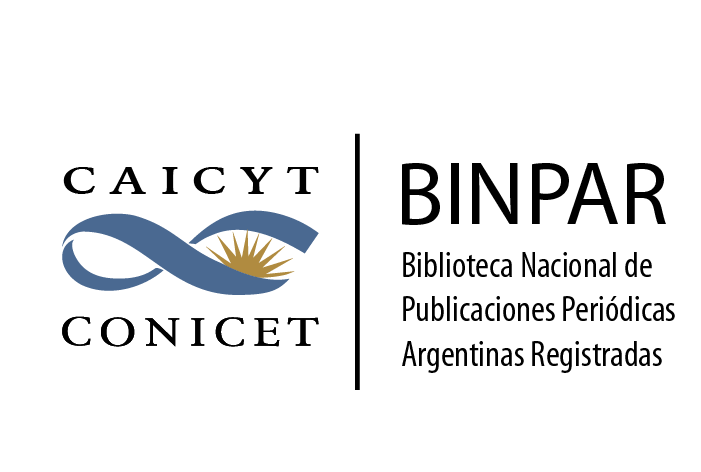New monthly precipitation database of Argentina (PMRAv1), 2000-2022
DOI:
https://doi.org/10.24215/1850468Xe032Keywords:
regression random forest, rain gauges, precipitation estimationAbstract
The accurate representation of spatio-temporal precipitation patterns is an essential input for numerous environmental applications. However, the estimation of precipitation patterns derived solely from rain gauges is subject to large uncertainties, especially in data-scarce regions. We present a new database of Monthly Precipitation of the Argentine Republic (PMRAv1) for the period 2000-2022, with 5 km of spatial resolution. PMRAv1 employs a Regression Random Forest-based methodology to combine monthly data from ground measurements (ranging from 142 to 227 rain gauges in each month) and four global precipitation products derived from satellite-estimated precipitation, global atmospheric circulation models or interpolation of ground-measured data (TERRACLIMATE, ERA5-LAND, GPMv6 y PERSIANN-CDR) with the aim of improving the estimation of monthly precipitation in Argentina. The developed methodology enhanced the spatio-temporal representation of precipitation by allowing the fusion of multiple sources of satellite information and ground measurements. Validation performed using 30% of the rain gauge data showed that PMRAv1 significantly improves the parameters RMSE, MAE, EM and R2 compared to the four global precipitation products. Furthermore, the model was more stable in predicting the observed monthly values, presenting a lower standard deviation in the three adjustment parameters. The PMRAv1 database is available to users in several formats. The term ‘v1’ (version 1) refers to the fact that this product will have successive future versions in the future that will update and refine the precision of the estimates. Likewise, the method presented could also be used to improve the estimation of other climatological variables when ground-based data are available.
Downloads
References
Abatzoglou, J.T., Dobrowski, S.Z., Parks, S.A. y Hegewisch, K.C., 2018: Terraclimate, a high-resolution global dataset of monthly climate and climatic water balance from 1958-2015, Scientific Data 5:170191. https://doi.org/10.1038/sdata.2017.191
Adhikary, S. K., Yilmaz, A. G., y Muttil, N., 2015: Optimal design of rain gauge network in the Middle Yarra River catchment, Australia. Hydrological Processes, 29(11), 2582-2599. https://doi.org/10.1002/hyp.10389
Almonacid, L., Pessacg, N., Diaz, B. G., Bonfili, O., y Peri, P. L., 2021: Nueva base de datos reticulada de precipitación para la provincia de Santa Cruz, Argentina. Meteorologica, 46 (2), https://doi.org/10.24215/1850468Xe007
Andersen, J., Dybkjaer, G., Jensen, K. H., Refsgaard, J. C., y Rasmussen, K., 2002: Use of remotely sensed precipitation and leaf area index in a distributed hydrological model. Journal of Hydrology, 264(1-4), 34-50. https://doi.org/10.1016/S0022-1694(02)00046-X
Ashouri, H., Hsu, K.L., Sorooshian, S., Braithwaite, D.K., Knapp, K.R., Cecil, L.D., Nelson, B.R. y Prat, O.P., 2015: Persiann-CDR daily precipitation climate data record from multisatellite observations for hydrological and climate studies. Bull. Am. Meteorol. Soc., 96, 69–83. https://doi.org/10.1175/BAMS-D-13-00068.1
Baez-Villanueva, O.M., Zambrano-Bigiarini, M., Beck, H. E., McNamara, I., Ribbe, L., Nauditt, A., ... y Thinh, N.X., 2020: RF-MEP: A novel Random Forest method for merging gridded precipitation products and ground-based measurements. Remote Sensing of Environment, 239, 111606. https://doi.org/10.1016/j.rse.2019.111606
Biancari, L., Oñatibia, G.R., Gaitán, J.J. y Aguiar, M.R., 2023: Coexistence of grasses and shrubs in Patagonian steppes. Norm or exception? Journal of Vegetation Science, 34, e13177. https://doi.org/10.1111/jvs.13177
Chao, L., Zhang, K., Li, Z., Zhu, Y., Wang, J., Yu, Z., 2018: Geographically Weighted Regression Based Methods for Merging Satellite and Gauge Precipitation. Journal of Hydrology. 558, 275–289. https://doi.org/10.1016/j.jhydrol.2018.01.042
Falaschi, D., Berthier, E., Belart, J.M.C., Bravo, C., Castro, M., Durand, M., Villalba, R., 2023: Increased mass loss of glaciers in Volcán Domuyo (Argentinian Andes) between 1962 and 2020, revealed by aerial photos and satellite stereo imagery. Journal of Glaciology 69(273), 40–56. https://doi.org/10.1017/jog.2022.43
Fick, S.E. y Hijmans, R.J., 2017: WorldClim 2: new 1-km spatial resolution climate surfaces for global land areas. Int. J. Climatol. 37, 4302–4315. https://doi.org/10.1002/joc.5086
Gaitan, Juan; Biancari, Lucio, 2024: Anexo A - Series temporales. Precipitacion mensual por estacion.xlsx. figshare. Dataset. https://doi.org/10.6084/m9.figshare.25356649.v1
Garcia, M., Peters‐Lidard, C. D., y Goodrich, D. C., 2008: Spatial interpolation of precipitation in a dense gauge network for monsoon storm events in the southwestern United States. Water Resources Research, 44(5). https://doi.org/10.1029/2006WR005788
Harris, I., Jones, P.D., Osborn, T.J., y Lister, D.H., 2017: CRU TS4.00: Climatic Research Unit (CRU) Time-Series (TS) version 4.00 of high-resolution gridded data of month-by-month variation in climate (Jan. 1901- Dec. 2015). Centre for Environmental Data Analysis. https://dx.doi.org/10.5285/edf8febfdaad48abb2cbaf7d7e846a86
Huffman, G.J., Stocker, E.F., Bolvin, D.T., Nelkin, E.J., y Jackson T., 2019: GPM IMERG final precipitation L3 half hourly 0.1 degree × 0.1 degree V06, Greenbelt, MD, Goddard earth sciences data and information services center (GES DISC). https://doi.org/10.5067/GPM/IMERG/3B-HH/06
Kobayashi, S., Ota, Y., Harada, Y., Ebita, A., Moriya, M., Onoda, H., ... y Takahashi, K., 2015: The JRA-55 reanalysis: General specifications and basic characteristics. Journal of the Meteorological Society of Japan. Ser. II, 93(1), 5-48. https://doi.org/10.2151/jmsj.2015-001
Legates, D. R., y McCabe, G. J., 1999: Evaluating the use of “goodness-of-fit” measures in hydrologic and hydroclimatic model validation. Water Resour. Res., 35(1), 233– 241. https://doi.org/10.1029/1998WR900018
Manz, B., Buytaert, W., Zulkafli, Z., Lavado, W., Willems, B., Robles, L.A. y Rodríguez-Sánchez, J.P., 2016: High-resolution satellite-gauge merged precipitation climatologies of the Tropical Andes. J. Geophys. Res. Atmos., 121, 1190–1207. https://doi.org/10.1002/2015JD023788
Mohammed, J., Mengiste, Y., y P. Singh, V., 2023: Improving spatio-temporal precipitation estimates in data scarce river basins: an application of machine learning-based multi-source data merging. Stochastic Environmental Research and Risk Assessment, 37(4), 1353-1369. https://doi.org/10.1007/s00477-022-02346-4
Muñoz-Sabater, J., Dutra, E., Agustí-Panareda, A., Albergel, C., Arduini, G., Balsamo, G., Boussetta, S., Choulga, M., Harrigan, S., Hersbach, H., Martens, B., Miralles, D. G., Piles, M., Rodríguez-Fernández, N. J., Zsoter, E., Buontempo, C., and Thépaut, J.N., 2021: ERA5-Land: a state-of-the-art global reanalysis dataset for land applications. Earth Syst. Sci. Data, 13, 4349–4383. https://doi.org/10.5194/essd-13-4349-2021
Nguyen, G. V., Le, X. H., Van, L. N., Jung, S., y Lee, G., 2023: Machine learning approaches for reconstructing gridded precipitation based on multiple source products. Journal of Hydrology: Regional Studies, 48, 101475. https://doi.org/10.1016/j.ejrh.2023.101475
Nguyen, G. V., Le, X. H., Van, L. N., Jung, S., Yeon, M., y Lee, G., 2021: Application of random forest algorithm for merging multiple satellite precipitation products across South Korea. Remote Sensing, 13(20), 4033. https://doi.org/10.3390/rs13204033
Peretti, M., Spennemann, P.C. y Long, M.E.F., 2023: Trends in soil moisture content and water deficits in Argentina and the role of climate contribution. Theor Appl Climatol 152, 1189–1201. https://doi.org/10.1007/s00704-023-04428-x
Qi, J., Markewitz, D., y Radcliffe, D., 2018: Modelling the effect of changing precipitation inputs on deep soil water utilization. Hydrological Processes, 32(5), 672-686. https://doi.org/10.1002/hyp.11452
Stisen, S., Højberg, A. L., Troldborg, L., Refsgaard, J. C., Christensen, B. S. B., Olsen, M., y Henriksen, H. J., 2012: On the importance of appropriate precipitation gauge catch correction for hydrological modelling at mid to high latitudes. Hydrology and Earth System Sciences, 16(11), 4157-4176. https://doi.org/10.5194/hess-16-4157-2012
Tovar, C., Carril, A.F., Gutiérrez, A.G., Ahrends, A., Fita, L., Zaninelli, P., ... y Hollingsworth, P.M., 2022: Understanding climate change impacts on biome and plant distributions in the Andes: Challenges and opportunities. Journal of Biogeography, 49(8), 1420-1442. https://doi.org/10.1111/jbi.14389
Verdin, A., Funk, C., Rajagopalan, B. y Kleiber, W., 2016: Kriging and Local Polynomial Methods for Blending Satellite-Derived and Gauge Precipitation Estimates to Support Hydrologic Early Warning Systems. IEEE Transactions on Geoscience and Remote Sensing, 54(5), 2552-256. https://doi.org/10.1109/TGRS.2015.2502956
Villarini, G., y Krajewski, W. F., 2008: Empirically-based modeling of spatial sampling uncertainties associated with rainfall measurements by rain gauges. Advances in Water Resources, 31(7), 1015-1023. https://doi.org/10.1016/j.advwatres.2008.04.007
Villarini, G. y Krajewski, W.F. Review of the Different Sources of Uncertainty in Single Polarization Radar-Based Estimates of Rainfall., 2009: Surv. Geophys. 31, 107–129. https://doi.org/10.1007/s10712-009-9079-x
Wang L, Jiao W, MacBean N, Rulli MC, Manzoni S, Vico G, y D’Odorico P., 2022: Dryland productivity under a changing climate. Nature Climate Change 12: 981–994. https://doi.org/10.1038/s41558-022-01499-y
Woldemeskel, F. M., Sivakumar, B., y Sharma, A., 2013: Merging gauge and satellite rainfall with specification of associated uncertainty across Australia. Journal of Hydrology, 499, 167-176. https://doi.org/10.1016/j.jhydrol.2013.06.039
Xie, P., y Xiong, A. Y., 2011: A conceptual model for constructing high‐resolution gauge‐satellite merged precipitation analyses. Journal of Geophysical Research: Atmospheres, 116(D21). https://doi.org/10.1029/2011JD016118
Zhang, L., Li, X., Zheng, D., Zhang, K., Ma, Q., Zhao, Y., y Ge, Y., 2021: Merging multiple satellite-based precipitation products and gauge observations using a novel double machine learning approach. Journal of Hydrology, 594, 125969. https://doi.org/10.1016/j.jhydrol.2021.125969
Zhang, L., Ren, D., Nan, Z., Wang, W., Zhao, Y., Zhao, Y., Ma, Q., y Wu, X., 2020: Interpolated or satellite-based precipitation? Implications for hydrological modeling in a meso-scale mountainous watershed on the Qinghai-Tibet Plateau. Journal of Hydrology 583, 124629. https://doi.org/10.1016/j.jhydrol.2020.124629
Zuur, A.F., Ieno, E.N., Elphick, C.S., 2010: A protocol for data exploration to avoid common statistical problems. Methods in Ecology and Evolution 1: 3–14. https://doi.org/10.1111/j.2041-210X.2009.00001.x
Downloads
Additional Files
Published
Versions
- 2024-12-02 (2)
- 2024-06-28 (1)
Issue
Section
License
Copyright (c) 2024 Juan J. Gaitan, Lucio Biancari

This work is licensed under a Creative Commons Attribution-NonCommercial-ShareAlike 4.0 International License.
According to these terms, the material may be shared (copied and redistributed in any medium or format) and adapted (remixed, transformed and created from the material another work), provided that a) the authorship and the original source of publication (journal and URL of the work) are cited, b) it is not used for commercial purposes and c) the same terms of the license are maintained.



























